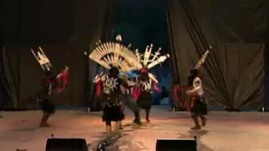Teachers' Domain - Digital Media for the Classroom and Professional Development
User: Preview



The Apache Crown Dancers are enrolled members of the White Mountain Apache Tribe and live in Whiteriver, Ariz. In this video segment, they perform a traditional Crown Dance in full regalia to music sung by the group leader, Joe Tohonnie, Jr.
This resource is part of the Native American Culture collection.
Find additional arts resources for your classroom at the KET Arts Toolkit website.
Crown Dancing is sacred to the White Mountain Apache people. It is part of ceremonies such as the Girl’s Puberty Ceremony, which marks a girl’s entry into young womanhood.
Crown Dances are also performed for very specific ceremonies that are held only at a certain time and a certain place. The dances honor the four directions and the deer. Deer are considered both food and medicine by the White Mountain Apache. The WMA people believe that Crown Dancing keeps the people in balance with their environment and ensures their survival.
Like some other ceremonial Native American dances, the dances have been modified so that they can be shared with outsiders without compromising the sacred nature of the dance, but it is still performed as a blessing.
When the Crown Dance begins, the dancers may move in unison in a circle or a line, but the rest of the dance is not choreographed. In other words, it might look differently each time it is performed. The dancers are moved by the song and the story it tells. Many of the movements represent animals.
There are five Crown Dancers. Four of them represent the different directions—North, South, East, West—and the fifth is said to have been sent from heaven to guide the other four, to show them how to live, what herbs to use, and how to pray.
Joe Tohonnie, Jr., the singer and leader of the White Mountain Crown Dancers, makes the crowns that the dancers wear to represent the four directions. They must be finished within four days. During the dances, each direction is acknowledged, beginning with the east, where the sun rises. Next the south is acknowledged, then the west and north.
The Crown Dance is a form of prayer and a blessing. Training to be a Crown Dancer requires much more than learning how to do certain steps and which regalia to wear. The Crown Dancers are called Gan, or Mountain Spirits, and they learn the traditional wisdom of their people. Part of the training involves going into the sweat lodge to pray and to learn to use their minds in different ways. Dancers always carry sacred herbs with them including the pollen from cattails.
 Loading Standards
Loading Standards